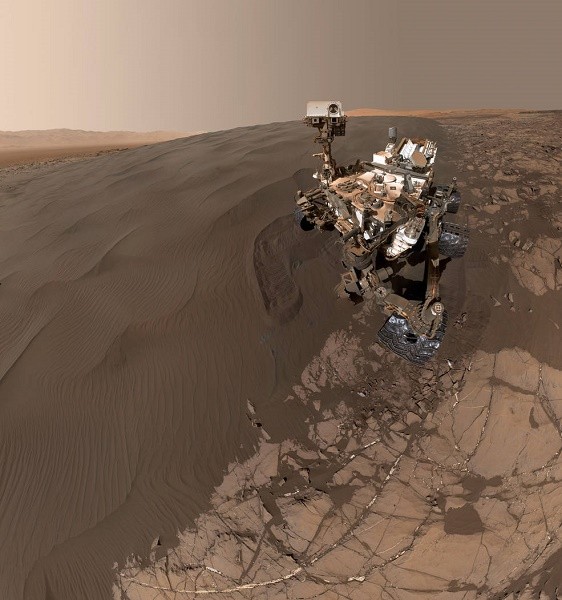By Ana Verayo, | February 01, 2016

A team of archaeologists has already plotted which part of Mars NASA should explore first.
NASA's Opportunity rover just celebrated 12 years on Mars, but not to be upstaged, NASA's Curiosity rover took the time to tweet one of its selfies to say hello to Earth's denizens.
Like Us on Facebook
The rover's mission is to analyze rock and soil samples and then transmitting precious data back to Earth, that has been active since 2012. The latest series of photos taken by Curiosity involves 57 images that were all taken last January 19 where the rover used its camera attached to its arm to capture a panoramic shot of the Namib Dune located at the foothills of the highest point in Mars, Mount Sharp.
The Martian landscape can be often seen as an endless terrain of brown, dusty land formations where Curiosity has been conducting tests on different soil samples with its onboard suite of scientific instruments. NASA scientists are now analyzing the latest chemical composition of sand particles taken from the mysterious Martian sand dunes, investigating how sand can move in an environment with a tenuous atmosphere and lesser gravity than Earth.
However, during the process of collecting these various Martian samples, one of the rover's scientific instruments stopped working called the thwack actuator. The thwack actuator is designed to tap the sampler to clear away the sieve of old sand, but unfortunately, the device stopped responding to commands where mission controllers decide to turn down the power while running diagnostics.
According to deputy project manager, Steve Lee for NASA's Curiosity at the Jet Propulsion Laboratory, despite this technical difficulty, the rover responded properly to this unexpected event. The rover stopped moving its actuator and further use of the arm along with its sampling system.
To date, the team is still waiting for the complete diagnostic as Curiosity will be using its measuring systems that can obtain data from wind strength and direction.
Also. this is not the first time that Curiosity has beamed back selfies from Mars. Its first selfie was taken last 2014, celebrating its one year anniversary on the Red Planet or 687 Earth days. To date, Curiosity has been on the alien world for 1,239 sols or Martian days where its main route is around Mount Sharp to gather more crucial data about the geological evolution of the planet. When it finishes collecting and analyzing samples from the Namib sand dune, the rover will move to a new region and drill for more rock samples.
-
Use of Coronavirus Pandemic Drones Raises Privacy Concerns: Drones Spread Fear, Local Officials Say

-
Coronavirus Hampers The Delivery Of Lockheed Martin F-35 Stealth Fighters For 2020

-
Instagram Speeds Up Plans to Add Account Memorialization Feature Due to COVID-19 Deaths

-
NASA: Perseverance Plans to Bring 'Mars Rock' to Earth in 2031

-
600 Dead And 3,000 In The Hospital as Iranians Believed Drinking High-Concentrations of Alcohol Can Cure The Coronavirus

-
600 Dead And 3,000 In The Hospital as Iranians Believed Drinking High-Concentrations of Alcohol Can Cure The Coronavirus

-
COVID-19: Doctors, Nurses Use Virtual Reality to Learn New Skills in Treating Coronavirus Patients







